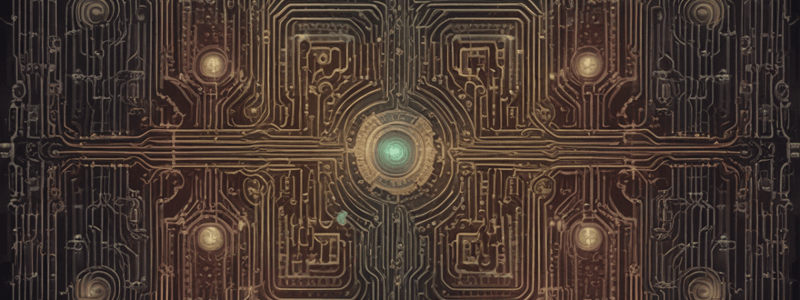Podcast
Questions and Answers
What is the primary motivation behind the development of Low-Power TTL?
What is the primary motivation behind the development of Low-Power TTL?
- To address power consumption issues (correct)
- To reduce the physical size of devices
- To increase the number of devices in a circuit
- To improve speed
What is the key component that enhances speed and reduces power consumption in Schottky TTL?
What is the key component that enhances speed and reduces power consumption in Schottky TTL?
- Schottky diodes (correct)
- Resistors
- Transistors
- Capacitors
What is the characteristic that distinguishes Advanced Schottky TTL from Schottky TTL?
What is the characteristic that distinguishes Advanced Schottky TTL from Schottky TTL?
- Further improvements in speed and power consumption (correct)
- Increased physical size
- Lower power dissipation
- Faster switching speeds
What is the prefix of part numbers for Low-Power TTL devices?
What is the prefix of part numbers for Low-Power TTL devices?
What is the primary advantage of Schottky TTL over standard TTL?
What is the primary advantage of Schottky TTL over standard TTL?
Which type of TTL consumes the most power?
Which type of TTL consumes the most power?
What is the main goal of developing Advanced Schottky TTL?
What is the main goal of developing Advanced Schottky TTL?
What is the prefix of part numbers for Advanced Schottky TTL devices?
What is the prefix of part numbers for Advanced Schottky TTL devices?
What is the characteristic that Low-Power TTL and Schottky TTL have in common?
What is the characteristic that Low-Power TTL and Schottky TTL have in common?
What is the primary difference between Schottky TTL and Fast TTL?
What is the primary difference between Schottky TTL and Fast TTL?
Flashcards are hidden until you start studying
Study Notes
Basic Logic Circuits
- Basic logic circuits are essential for digital electronics, using binary signals (0s and 1s) to perform logical operations.
- NOT Gate (Inverter): Produces the opposite of its input.
- AND Gate: Outputs high (1) only when all inputs are high (1).
- OR Gate: Outputs high (1) when at least one input is high (1).
- NAND Gate: Outputs low (0) only when all inputs are high (1); complement of AND.
- NOR Gate: Outputs low (0) when at least one input is high (1); complement of OR.
- XOR Gate (Exclusive OR): Outputs high (1) when an odd number of inputs are high.
- XNOR Gate (Exclusive NOR): Outputs high (1) when an even number of inputs are high.
- Buffers pass input to output without logical operations, enhancing signal strength.
Logic Gate Characteristics
- Logic gates serve distinct functions based on input combinations, guiding digital circuit design.
- Each gate's operation can be outlined in a truth table, showing input-output relationships:
- NOT: Outputs complement of input.
- AND: Outputs high only for all high inputs.
- OR: Outputs high for at least one high input.
- NAND: Outputs low only for all high inputs.
- NOR: Outputs low for any high input.
- XOR: Outputs high when input count is odd.
- XNOR: Outputs high when input count is even.
Propagation Delay
- Propagation delay is the time for a signal to travel from input to output in a logic gate.
- Measured from the midpoint of input and output waveforms.
- Types:
- Rising Propagation Delay (tPLH): Time for output to transition low to high.
- Falling Propagation Delay (tPHL): Time for output to transition high to low.
- Factors affecting propagation delay:
- Transistor characteristics, load capacitance, technology node, temperature, and voltage levels all influence speed.
- Importance:
- Propagation delays affect circuit speed, signal integrity, maximum operating frequency, timing analysis, and power consumption.
NMOS Inverter
- An NMOS inverter performs logical inversion using NMOS transistors.
- Appears in CMOS technology, usually paired with a PMOS inverter.
- Operation:
- NMOS conducts when input is high, output is low (0).
- NMOS is off when input is low, allowing output to be high (1).
- Characteristics include inversion function and reliance on NMOS for pull-down operations.
NMOS Logic Gates
- NMOS logic gates use N-type transistors as active components for basic logic operations.
- NMOS Inverter: Inverts input signal; low resistance to ground when input is high.
- NMOS NOR Gate: Outputs low only when all inputs are high; relies on parallel transistor arrangements.
- NMOS NAND Gate: Outputs high only when not all inputs are high; uses series arrangements for operation.
- Characteristics include inversion capability, pull-down functionality, and ground-referenced output.
CMOS Inverter
- A CMOS inverter combines NMOS and PMOS transistors to maximize efficiency.
- NMOS turns on for low input, pulling output low; PMOS turns on for high input, pulling output high.
- Characterized by low power consumption, high noise margins, and fast switching speeds.
CMOS Logic Gates
- CMOS gates incorporate both NMOS and PMOS transistors for robust digital logic operations.
- CMOS Inverter: Provides output based on the complement of input; uses both NMOS and PMOS for efficient function.
- CMOS NAND and NOR Gates: Conditional outputs based on arrangements of series and parallel transistors.
- CMOS AND and OR Gates: Defined by how transistors are interconnected for high or low outputs.
- Characteristics include low power consumption, high noise margins, efficient operation, and wide fan-out capabilities, enhancing circuit performance.### CMOS Logic Gates
- Essential for creating complex digital systems, widely utilized in integrated circuits, microprocessors, and memory devices.
BJT Inverter
- Fundamental building block in digital electronics, primarily used for signal inversion.
- Uses a single NPN or PNP transistor along with biasing resistors.
- When a high input (logic 1) is applied, the NPN transistor saturates, resulting in a low output (logic 0).
- Conversely, a low input (logic 0) causes the NPN transistor to cut off, pulling the output high (logic 1).
- Requires proper biasing for effective operation in the active region.
TTL (Transistor-Transistor Logic)
- A digital logic family utilizing BJTs to implement logic functions.
- Operates with defined voltage levels: HIGH (2.4V - 5V) and LOW (0V - 0.8V).
- Limited fan-out capability, affecting the number of inputs it can drive.
- Moderate noise immunity but higher power consumption compared to CMOS.
- Various TTL sub-families exist, including standard TTL, low-power TTL (LPTTL), and Schottky TTL.
NAND Gates
- Perform the NOT-AND operation, outputting LOW (0) only when all inputs are HIGH (1).
- The universal gate, capable of constructing any logic gate using only NAND gates.
- Commonly applied in memory devices, arithmetic circuits, sequential logic, and programmable logic devices.
- Implemented using transistors or other electronic components.
TTL Output Characteristics
- HIGH output voltage typically ranges from 2.4V to 5V; LOW output voltage between 0V and 0.8V.
- Known for current-sinking ability, active in providing a logic LOW.
- Limited fan-out, affecting performance when driving multiple inputs.
- Relatively low output impedance, making it effective for low-impedance loads.
- Specific output current parameters (IOH and IOL) dictate the gate's load-driving capability.
- Moderate power consumption, with low-power variants developed to mitigate this issue.
- Noise margins are well-defined, contributing to circuit reliability against noise.
TTL Logic Families
- Standard TTL (STTL) introduced in the 1960s, known for good performance and higher power consumption.
- Different families offer unique features: low-power variants aimed at reducing energy consumption and Schottky TTL designed for higher speed and efficiency.
Applications of NAND Gates
- Vital for constructing memory devices like NAND flash memory.
- Employed in designing arithmetic circuits, multiplexers, and sequential logic components.
- Essential building blocks in various digital applications due to their versatility and efficiency.
Understanding these components and their functionalities is crucial for designing and analyzing digital circuits effectively.
Studying That Suits You
Use AI to generate personalized quizzes and flashcards to suit your learning preferences.





